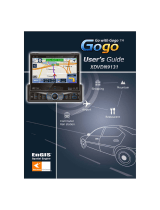
4
Make sure that both the Active Dock and your windscreen are clean and dry
before you attach the holder. Place the Active Dock so that it does not interfere
with your view of the road or of any of the controls in your car.
To attach the Active Dock, press the suction cup firmly against the windscreen
on an area where the glass is flat. Then twist the rubber grip near the base of
the Active Dock in a clockwise direction until you hear a click.
Home dock
The Home dock is used for charging your TomTom GO when it is not in the
car and for connecting your GO to your computer.
When connected to your computer, you can use TomTom HOME to manage
your GO.
GPS reception
When you first start your TomTom GO, the device may need a few minutes to
determine your GPS position and show your current location on the map. In
future, your position will be found much faster, usually within a few seconds.
To ensure reception of a strong GPS signal, your GO should be used outdoors.
Large objects such as tall buildings can sometimes interfere with reception.
The TomTom GO 940 includes Enhanced Positioning Technology or EPT. EPT
is automatically used to estimate your location when the GPS signal is lost
while you are driving, such as when you are driving through a tunnel. When
EPT is being used, an icon is shown on the Status bar.
Safety Notice
Your TomTom GO contains a GSM/GPRS module which can interfere with
electrical devices such as cardiac pacemakers, hearing aids and aviation
equipment.
Interference with these devices may endanger the health or life of others.
Do not use near unprotected electrical units nor in areas where the use of
mobile telephones is prohibited, such as hospitals and airplanes.
Take care of your TomTom GO
Never leave your TomTom GO or accessories on view when you leave the car
or they may become an easy target for thieves.
You can set a password for your TomTom GO which must be entered every
time you start your GO.
It is important to take care of your GO.
• Your GO is not designed for use in extreme temperatures and any such
exposure may cause permanent damage.
• Do not open the casing of your GO under any circumstances. Doing so may
be dangerous and will invalidate the warranty.
• Wipe or dry the screen of your GO using a soft cloth. Do not use any liquid
cleaners.




















